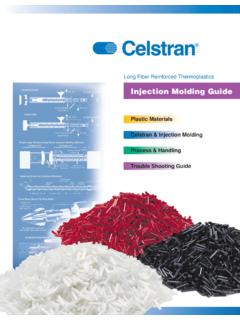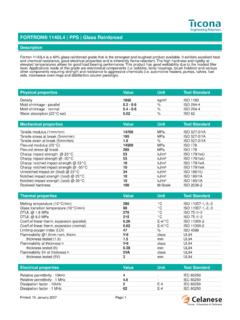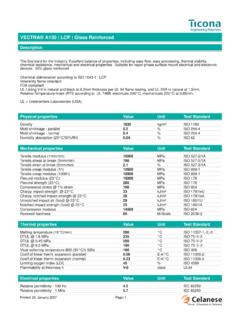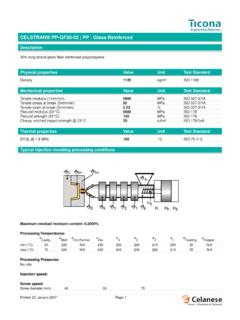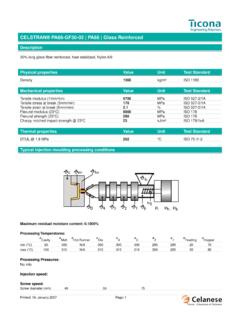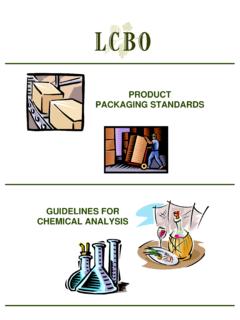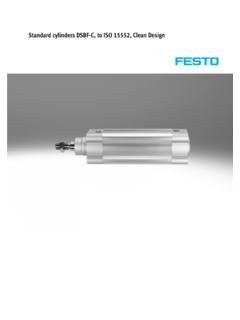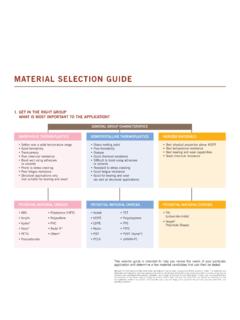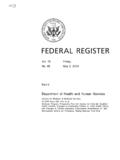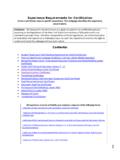Transcription of Fortron PPS Product Brochure (B240) - Hi Polymers
1 Fortron Polyphenylene sulphide (PPS)For tron Polyphenylene sulphide (PPS) continuous servicetemperatureup to +240 C inherently flameretardant high hardness andrigidity low creep very good chemicalresistancePolyphenylene sulphide (PPS) Fortron , supply forms, colour range,quality grade masterbatches, under short-term under long-term and abrasion water to service = registered trademarkPolyphenylene sulphide (PPS) Fortron , wall design, design notes, sprue and gate from another thermoplasticto from Fortron to Thermal stress of the Extraction at the processing Fire information on recommendations for of Fortron with of supplement showing (selection):1 Physical properties3 Status of Fortron in UL tests4 CSA rating6 Resistance to chemicals134567891012 IntroductionGrades, supply forms,colour range, quality managementPropertiesResistance to service environment effectsProcessing, finishingUse of recyclatesUL cardsPhoto supplementshowing typical applicationsSubject indexLiteraturePolyphenylene sulphide (PPS) Fortron 1.
2 IntroductionFortron is a linear, partially crystalline polypheny-lene sulphide. A phenylene ring and sulphur atomform the backbone of the macromolecule and giveFortron a number of unusual properties [1], [2]: continuous service temperatures up to 240 C, short-term exposure up to 270 C, inherently flame-retardant (UL 94: V-0, somegrades 5 VA), very good chemical and oxidation resistance, high hardness and rigidity, very low water absorption, low creep, even at elevated combination of properties places Fortron in thecategory of a high-performance is suitable for the manufacture of mouldingswith good mechanical properties and most important applications for Fortron are inthe electrical and electronics industries (e. g. plugs andmultipoint connectors, bobbins, relays, switches,encapsulation of electronic components). Fortron isbeing employed increasingly in the automotive indus-try (air intake systems, pumps, valves, gaskets, com-ponents for exhaust gas recirculation systems).
3 Fortron is also used to produce components formechanical and precision many components exposed to high service stres-ses, Fortron is the preferred alternative to light-metalalloys, thermosets and many other thermoplastics. = registered trademark2. Grades, supply forms,colour range,quality managementFortron is supplied in powder and pellet form. Thecurrent range of grades is described in section compounding Fortron with glass fibres and glassfibre/mineral filler blends, its rigidity, strength andheat resistance can be considerably Fortron range includes extrusion and injectionmoulding grades with different types and levels ofadditive and different melt viscosities. Speciallyeasyflowing grades 1140L6, 4184L6, 6850L6 and6165A6 are available for thinwalled mouldings withunfavourable flow length/wall thickness ratios. Theirproperties are comparable with those of the corre-sponding grades with medium powder grades offer a variety of possibilities foruse in powder technology, e.
4 G. as heat-resistantbinders or additives in PTFE unreinforced pellet grades are used mainly forfibre manufacture (monofilaments and multifila-ments) and for special applications in extrusion(e. g. pipes, semi-finished products, films). Section an range of grades is currently being details are available on sulphide (PPS) Fortron Fortron grade rangeReinforced gradesFillersDescription(pellets)1131L43 0 % (w/w) glass fibresinjection moulding grade, medium-range melt viscosity,permits flash-free production of complicated mouldings1140L440 % (w/w) glass fibresinjection moulding grade, medium-range melt viscositywith little tendency to form flash1140L640 % (w/w) glass fibresinjection moulding grade, like 1140L4 but with lower meltviscosity1140E740 % (w/w) glass fibresimproved injection moulding grade, low melt viscosity withlittle tendency to form flash4184L450 % (w/w)injection moulding grade, comes between 1140L4 andglass fibres/mineral6165A4 in terms of properties4184L650 % (w/w)injection moulding grade, like 4184L4 but with lower meltglass fibres/mineralviscosity4665B665 % (w/w)
5 Injection moulding grade, like 6165A4/A6 but with betterglass fibres/mineraltracking resistance and very low warpage6160B460 % (w/w)injection moulding grade, lower density, low corrosion,glass fibres/mineralspecially suitable for electronic components6165A465 % (w/w)injection moulding grade, medium-range melt viscosity, lowerglass fibres/mineralshrinkage and warpage than glass-fibre-reinforced grades6165A665 % (w/w)injection moulding grade, like 6165A4 but with lower meltglass fibres/mineralviscosity6850L650 % (w/w)injection moulding grade, low melt viscosity, very lowglass fibres/mineralwarpage1140L040 % (w/w) glass fibresextrusion gradeUnreinforced grades Supply formDescription(powder and pellets)0203B6coarse powder (averagevery low melt viscosityparticle size 300 m), good free-flowing properties0203P6pelletsvery low melt viscosity (can be supplied on request)0205B4coarse powder (averagelow melt viscosityparticle size 300 m),good free-flowing properties0205B4/20 mfinely ground powderfor powder technology, e.
6 G. as heat-resistant binder,(average particle sizeas additive in PTFE compounds 20 m)0205P4pelletslow melt viscosity0214B1coarse powder (averagemedium-range melt viscosityparticle size 300 m),good free-flowing properties0214C1pelletsmedium-range melt viscosity0320B0coarse powder (averagehigh melt viscosityparticle size 300 m),good free-flowing properties0320C0pelletshigh melt viscosityPolyphenylene sulphide (PPS) Fortron Colour masterbatches, colorationThe reinforced grades are supplied in natural, blackand brown colours and the unreinforced grades innatural coloration of Fortron is possible and servesto identify and distinguish this purpose, a range of Fortron colour master-batches with a high pigment content is masterbatches are supplied as granules and areused to colour natural Fortron grades. The recom-mended concentrations are 40 : 1 for black andbrown, 20 : 1 for the other processors wish to use their own colorants, onlypigments which can resist the processing temperaturesof Fortron (up to 350 C) without decomposition orcolour change may be employed.
7 The pigment con-tent should not exceed (w/w). Higher pigmentcontents may cause a reduction in mechanical pro-perties and following colour masterbatches are currentlyavailable:SD3002 K40blackSJ3013 K20greenSY3004 K40brownSN3012 K20orangeSC3010 K20dark greySL3017 K20yellowSC3011 K20pale greySS3006 K20redSG3005 K20blueAll colour masterbatches are properties such as tensile strength andelongation at break may be slightly altered by theaddition of should be noted that formulations cannot be ex-pected to give a permanently true colour match. Thisis because photooxidative reactions taking place underlight and heat lead to colour changes in very thin edgelayers of components. No change in mechanical pro-perties has been detected in such Quality managementWithin the Ticona Group in Europe the FortronProduct Team has obtained registration acc. to ISO9001 and QS-9000 (DOS [German Association forthe Certification of Quality Systems], reg.)
8 No. 2719).This indicates that the quality system meets the requirements of this international standard. The useof SPC methods to monitor Product quality is part ofthis quality system (see also the brochures QualityAssurance Polymer Material and Statistical ProcessControl ).By regular self-assessment in accordance with theautomotive requirements of QS-9000 we are con-stantly developing our quality system to meet theneeds of our foster effective partnerships with our customerswe offer to conclude quality agreements and also toissue test certificates. These agreements document thespecifications for our products. In addition, we canagree to issue an inspection certificate in accordancewith EN 10 This contains measured valuesrelating to the batch of which the delivery is sulphide (PPS) Fortron 52 Polyphenylene sulphide (PPS) Fortron 3. PropertiesThis section discusses the important characteristicproperties of Fortron .
9 They have been determinedlargely by standard test physical property values of Fortron are given intable 1 on pages 8 and 9. This table is also available asa pull-out leaflet (B 260 FB E).Descriptions of the Fortron grades and their proper-ties are available on the CAMPUS data base dis-kette. This diskette can be used on IBM-compatiblePCs; the diskette can be ordered by telephoning(++ 49-69) 305 70 property values determined on test specimens bystandard test methods are guide values and can beused as a basis for comparing different they have only limited applicability tofinished parts. The strength of a component dependsto a great extent on its design and hence designstrength is the criterion used to assess Mechanical propertiesTo characterize the dependence of the mechanicalproperties of a plastic on temperature, the shearmodulus G and the mechanical loss factor d are used,fig.
10 1. CAMPUS = registered trademark of CWFG,Frankfurt am Main, Properties under short-term stressThe behaviour of materials under dynamic short-termstress can be examined in the tensile test according toISO 527-1, 2. This test enables important propertiesas tensile strength and strain at break to be 2 and 3 show the stress-strain properties ofFortron 1140L4 and 6165A4 at different temperatu-res. In the upper temperature range (150, 200 C), thevalues for strain at break are relatively high; this ismost marked with the 40% glass-reinforced gradeFortron properties measured under short-term stressare the different elastic moduli, i. e. the tensile modu-lus and flexural modulus, determined according toIO 527-1, 2 and ISO 178. The values provide an indi-cation of rigidity and are used not only to charac-terize plastics but also for strength calculation and thedesign of moulded 2 Stress/strain curves for Fortron 1140L4,measured at different temperatures0123%200 MPa150100500 Tensile strain at breakTensile strength23 C75 C150 C200 C 40 CFig.




